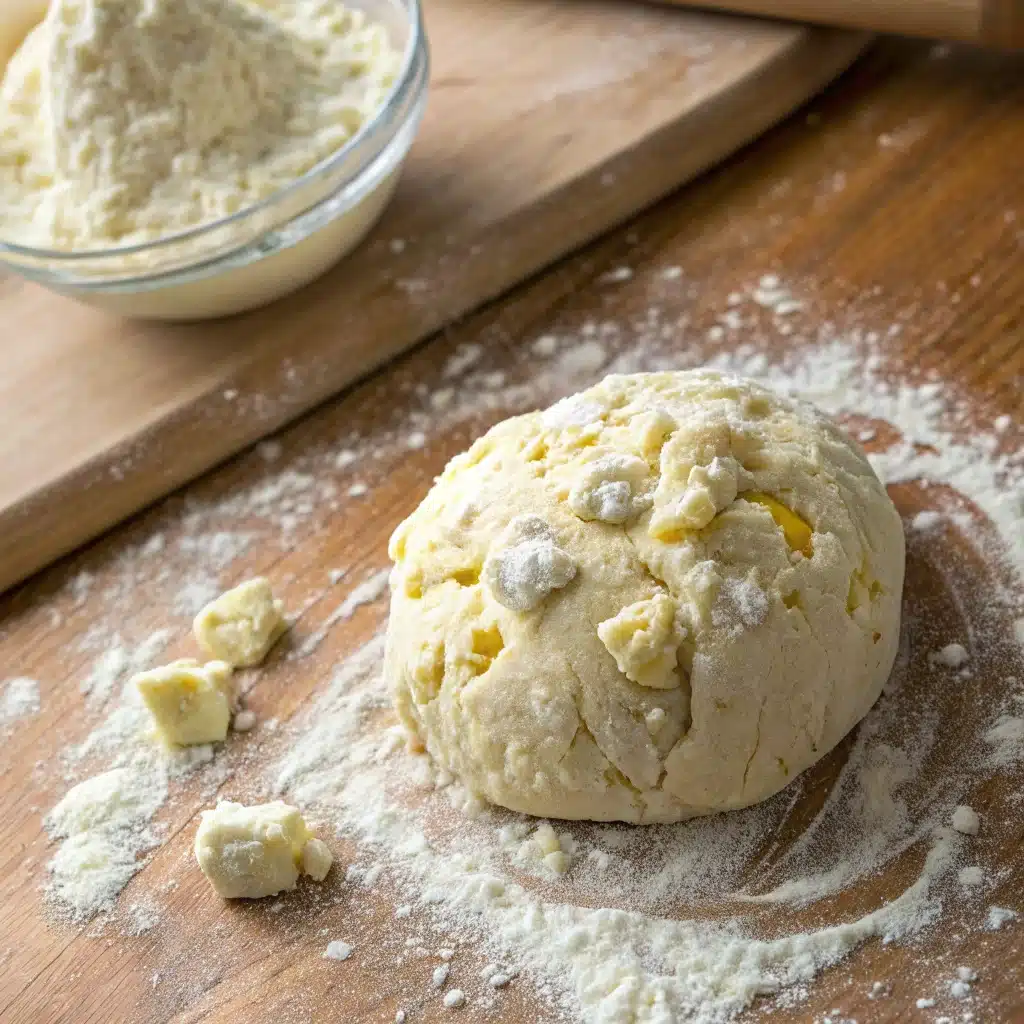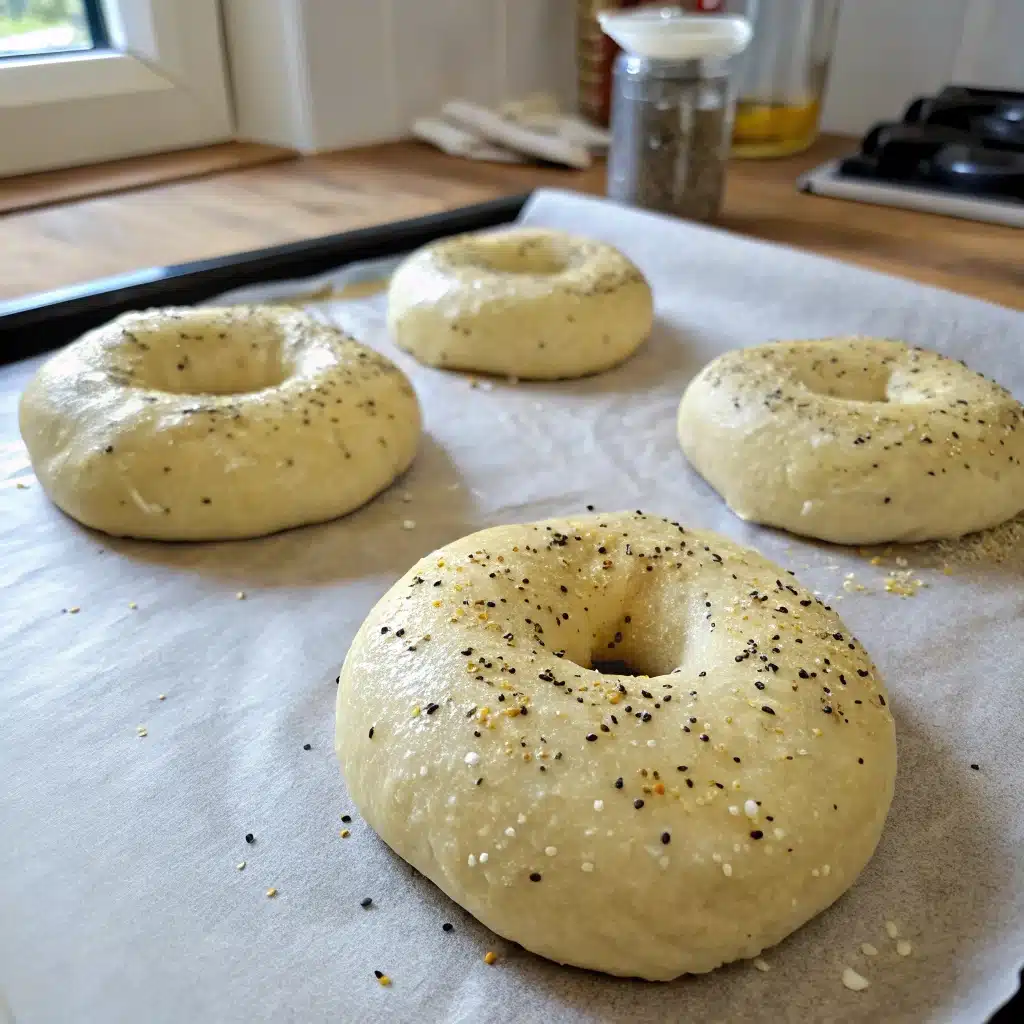Cottage Cheese Bagels with Bread Flour might sound like a quirky twist, but they’re quickly becoming a staple in my kitchen—and for good reason. I’m Mary, affectionately called The Pudding Lady here in Bath. My love affair with flour and baking began in my childhood, surrounded by tins of golden syrup, dust clouds of self-raising flour, and the kind of kitchen chaos that leads to unforgettable bakes. I was the little girl who waited eagerly to lick the spoon and eventually became the woman running weekend pudding clubs in her own flour-dusted kitchen.

Over the years, I’ve created sponges that melt in your mouth, puddings as rich as history books, and now—bagels that bring the same sense of nostalgia with a nutritious twist. These Cottage Cheese Bagels with Bread Flour combine the creamy richness of cottage cheese with the strength and chew of bread flour, giving you something hearty, chewy, and packed with protein.
Why this combo? Because cottage cheese makes the dough moist and subtly tangy, while bread flour delivers the chewy, golden crust we all crave. It’s the perfect bake when you want something filling yet fluffy—ideal for breakfast, brunch, or an afternoon pick-me-up.
If you’re looking for a way to level up your homemade bagels, this is it. Not only do Cottage Cheese Bagels with Bread Flour satisfy your cravings, but they also bring something unexpected to the table—comfort, structure, and a boost of nutrition.
Table of Contents
Introduction to Cottage Cheese Bagels with Bread Flour
What Makes Cottage Cheese Bagels a Trend in High-Protein Baking
Lately, there’s been a delicious shift in how health-conscious foodies think about breakfast. One of the hottest trends taking over home kitchens is cottage cheese bagels with bread flour. It’s not just a TikTok moment—it’s a smart, flavorful twist on traditional baking that’s rich in protein, chewy in texture, and surprisingly easy to make.
This combination caters to anyone looking for a high-protein, low-fat alternative to traditional bagels. Cottage cheese isn’t just for snacking anymore—it’s making waves as a baking staple thanks to its creamy texture and nutritional value. Paired with bread flour, which brings extra gluten strength for chewiness, these bagels are perfect for breakfast, post-workout snacks, or on-the-go meals.
You’ll find them all over wellness blogs and recipe roundups. But what makes cottage cheese bagels with bread flour stand out from the crowd is their perfect balance of flavor, texture, and nutrition. You’re not sacrificing taste for health here—you’re upgrading both.
Print
Cottage Cheese Bagels with Bread Flour
- Total Time: 40 minutes
- Yield: 4–6 bagels 1x
Description
These Cottage Cheese Bagels with Bread Flour are chewy, hearty, and high in protein. Perfect for breakfast, post-workout snacks, or meal prep, they blend the richness of cottage cheese with the gluten strength of bread flour for the ultimate homemade bagel.
Ingredients
- 2 cups bread flour
- 1 cup low-fat cottage cheese, blended smooth
- 2 tsp baking powder
- ½ tsp salt
- 1 egg, beaten (for egg wash)
- 2 tbsp everything bagel seasoning (optional)
Instructions
- In a large bowl, whisk together bread flour, baking powder, and salt.
- Add blended cottage cheese and mix until a sticky dough forms.
- Transfer dough to a floured surface and knead for 3–4 minutes until smooth.
- Divide dough into 4–6 pieces. Roll into balls and poke a hole through each to shape into bagels.
- (Optional) Boil bagels in simmering water for 30 seconds on each side, then remove and pat dry.
- Place bagels on a parchment-lined baking sheet. Brush with egg wash and sprinkle with seasoning if desired.
- Bake at 375°F (190°C) for 20–25 minutes until golden and firm. Cool slightly before serving.
Notes
Blend cottage cheese until smooth for best texture. Avoid over-kneading to keep the bagels tender. Store sliced bagels in freezer for easy reheating.
- Prep Time: 15 minutes
- Cook Time: 25 minutes
- Category: Breakfast
- Method: Baked
- Cuisine: American
Nutrition
- Serving Size: 1 bagel
- Calories: 190
- Sugar: 2g
- Sodium: 340mg
- Fat: 4g
- Saturated Fat: 2g
- Unsaturated Fat: 2g
- Trans Fat: 0g
- Carbohydrates: 25g
- Fiber: 2g
- Protein: 13g
- Cholesterol: 35mg
Why Use Bread Flour for Bagels Instead of All-Purpose Flour
When it comes to bagel baking, the type of flour you use can make or break the final product. Bread flour contains more protein—typically 12–14%—compared to all-purpose flour, which ranges from 9–11%, giving baked goods more structure and chew. That extra protein helps develop stronger gluten networks, giving your bagels that iconic chew and slightly crisp exterior.
So, why does this matter for cottage cheese bagels with bread flour? Because cottage cheese adds moisture and softness. If you used only all-purpose flour, the dough could turn out too soft or even gummy. Bread flour, on the other hand, balances that softness by building structure and bite. It’s like giving your bagels a backbone.
Plus, bread flour helps hold up to toppings like everything bagel seasoning, sesame seeds, or even a layer of melted cheese. Whether you’re baking plain or loaded bagels, using bread flour ensures your dough can handle it.
In short: If you want a chewy, bakery-style bagel at home, especially when using moist ingredients like cottage cheese, bread flour is your best friend. And it’s that combination—cottage cheese bagels with bread flour—that makes the difference between “pretty good” and “can’t-stop-eating” good.
Understanding the Role of Bread Flour in Bagels

Bread Flour vs. All-Purpose: What’s the Real Difference
If you’ve ever baked a bagel and felt it lacked that signature chew or didn’t rise quite right, the type of flour you used could be the culprit. While all-purpose flour is versatile and found in most kitchens, it simply doesn’t offer the same performance as bread flour when it comes to bagels—especially cottage cheese bagels with bread flour.
Bread flour contains more protein—usually around 12-14%—compared to all-purpose flour’s 9-11%. That extra protein is key to strong gluten development, which gives bagels their springy bite and dense texture. And when you’re baking cottage cheese bagels with bread flour, gluten strength is non-negotiable. It holds everything together, from the moist cheese to the boiled crust.
More gluten also means better dough structure. This is critical when baking with cottage cheese, which introduces additional moisture. Without the strength of bread flour, your dough could end up too soft and shapeless. Bread flour gives cottage cheese bagels a sturdy framework, allowing for a better rise, a clean bagel hole, and that signature chewiness we all crave.
You’ll also notice a big difference in appearance. Bagels made with bread flour bake up taller and more golden. With cottage cheese bagels made using bread flour, the crust turns out crisp but not dry, and the inside stays soft but not doughy.
Discover great ideas like our Cottage Cheese Gluten-Free Bagel for flour-free inspiration.
Protein Content in Bread Flour: Why It Matters for Chewy Bagels
Protein is the backbone of every solid bagel recipe. The more protein, the more gluten. And the more gluten, the better your dough can stretch, trap air, and hold up to boiling and baking. That’s why using bread flour in cottage cheese bagels is a game-changer.
When you’re making cottage cheese bagels with bread flour, you’re combining two power ingredients: the high-protein flour for strength and the cottage cheese for creaminess and extra protein. This combo not only results in a richer bite, but it also boosts the nutritional value—making these bagels a standout choice for anyone looking to eat smarter.
Cottage cheese adds moisture, and bread flour balances that by absorbing liquid more efficiently than all-purpose flour. This balance keeps the dough from becoming too tacky. As a result, your cottage cheese bagels with bread flour will be easier to shape, boil, and bake into perfect rounds every time.
Another major benefit? Bread flour gives the dough strength to withstand boiling—the step that locks in the signature bagel crust. Without enough protein, your cottage cheese bagels might fall apart before they even hit the oven. With bread flour, that risk disappears.
Looking for inspiration? Try our 2-Ingredient Bagel with Cottage Cheese recipe and see how flour upgrades texture.
Whether you’re baking your first batch or improving your go-to recipe, understanding the role of bread flour is key. And when paired with cottage cheese, it results in a bagel that’s both delicious and smart—a true win with cottage cheese bagels and bread flour at the center of it all.
Nutritional Benefits of Cottage Cheese in Bagels
Cottage Cheese as a Protein Powerhouse in Baking
Let’s talk about the real nutritional MVP of this recipe—cottage cheese. Not only is it creamy and light, but it’s loaded with protein and essential nutrients. A half-cup serving contains around 12 to 14 grams of protein, making it one of the most efficient dairy-based proteins you can use in baking.
When you combine cottage cheese with bread flour—another high-protein ingredient—you create the ultimate protein-packed duo. These cottage cheese bagels with bread flour don’t just taste great; they also deliver sustained energy that keeps you full for hours. That’s why this combo is gaining serious traction among fitness enthusiasts, meal preppers, and anyone seeking a smarter breakfast choice.
Cottage cheese also contributes calcium, B vitamins, and phosphorus, which support bone health and muscle recovery. This makes cottage cheese bagels with bread flour a balanced choice—not just for athletes, but for anyone looking to add nutrition to their baking without compromising flavor.
And let’s not overlook the texture. The cottage cheese adds moisture without excessive fat, working harmoniously with bread flour’s gluten strength to create a chewy-yet-soft interior that’s incredibly satisfying.
Looking for more protein-packed inspiration? Don’t miss our High Protein Cottage Cheese Bagels Recipe.
Cottage Cheese vs. Cream Cheese: Texture, Flavor, and Macros
Many people still confuse cottage cheese bagels with bread flour as a cream cheese alternative. While they both involve cheese, they serve entirely different roles in baking.
Cream cheese is rich and dense, high in fat, and most often used as a spread or creamy filling in both sweet and savory dishes. Cottage cheese, by contrast, is low-fat, light, and curdy. But when blended into dough, it turns smooth and melds beautifully with bread flour, enhancing both texture and moisture without overwhelming the flavor.
Let’s compare the two cheeses in terms of macros:
| Nutrient | Cottage Cheese | Cream Cheese |
|---|---|---|
| Calories | 98 kcal | 350 kcal |
| Protein | 11g | 6g |
| Fat | 4g | 34g |
| Carbs | 3g | 5g |
| Calcium | High | Moderate |
The difference is clear: cottage cheese delivers more protein and fewer calories. That’s why recipes for cottage cheese bagels with bread flour are often favored for meal plans focused on muscle building, fat loss, or blood sugar management.
In baking, cottage cheese also acts as a moisture agent. When combined with high-gluten bread flour, it prevents the dough from becoming overly dry or brittle. The result? Bagels that are dense but soft, chewy but not gummy—exactly how bagels should be.
Check out our Bethany Frankel Cottage Cheese Bagels for a celebrity-inspired spin on the trend.
For people looking to enjoy a comfort food classic without the calorie load, cottage cheese bagels with bread flour provide the perfect upgrade.
The Science Behind the Dough
What Do Cottage Cheese and Flour Make Together?
When it comes to bagel baking, the combination of cottage cheese and flour isn’t just creative—it’s functional. When blended, cottage cheese bagels with bread flour transform into a dough that’s soft, elastic, and full of structure. This pairing creates a nutritional and baking synergy that works remarkably well.
Cottage cheese brings in proteins (mainly casein), moisture, and a mild tang. Bread flour, on the other hand, contributes high gluten content that creates strength and chew. Together, these ingredients form a dough that holds shape beautifully, making it easier to knead, boil, and bake. The result? Perfectly textured cottage cheese bagels with bread flour that strike the ideal balance between density and softness.
Unlike doughs made with yogurt or ricotta, cottage cheese gives a creamier, more substantial bite without making the dough overly rich. It integrates seamlessly into high-gluten doughs, improving both texture and protein content.
Not to mention, cottage cheese bagels made with bread flour bake into golden, chewy rounds that feel satisfying and hearty. They’re especially great for breakfast sandwiches, spreads, or eaten plain right out of the oven.
Check out our 2-Ingredient Bagel with Cottage Cheese to explore minimal-ingredient alternatives.
The Role of Gluten Development in Bread Flour Bagels
Gluten development is essential when crafting classic-style bagels, and using bread flour in cottage cheese bagels is a must for achieving the right texture. Bread flour contains significantly more protein than all-purpose, which creates more gluten when hydrated and kneaded. That gluten forms long, elastic strands that help trap air during baking and build the chewy structure that’s iconic in every bagel.
When baking cottage cheese bagels with bread flour, you’re working with two moisture-heavy ingredients. But while cottage cheese softens the dough, the bread flour steps in to stabilize it. This balance ensures your bagels don’t collapse or come out too soft—they’ll hold their shape and provide the satisfying chew that makes bagels bagels.
Another advantage? Bread flour absorbs more liquid. That means you can add generous amounts of cottage cheese to your dough without worrying about stickiness. The gluten structure will still form properly, giving you the control you need during kneading and shaping.
During boiling, a common step before baking bagels, the gluten matrix created by bread flour resists breaking down—something that all-purpose flour can’t always handle. That’s why cottage cheese bagels with bread flour emerge from the oven with a tight, glossy crust and a dense, delicious interior.
Whether you’re prepping a batch for breakfast or freezing some for the week ahead, the combo of cottage cheese and bread flour delivers consistent results you can rely on.
Looking for variations? Discover great ideas like our Cottage Cheese Gluten-Free Bagel.
Step-by-Step Recipe for Cottage Cheese Bagels with Bread Flour

Ingredients List and Smart Substitutions
Making cottage cheese bagels with bread flour at home is surprisingly easy. You don’t need a mixer or fancy gear—just a bowl, a spoon, and a little patience. Below is the base recipe, along with smart substitutions you can use based on your dietary needs.
Essential Ingredients
| Ingredient | Quantity | Notes |
|---|---|---|
| Bread flour | 2 cups | High-protein content is key |
| Cottage cheese (low-fat) | 1 cup | Blend smooth for better texture |
| Baking powder | 2 tsp | Helps the dough rise |
| Salt | ½ tsp | Balances the flavor |
| Egg (for egg wash) | 1, beaten | Optional but adds shine |
| Everything bagel seasoning | 2 tbsp (optional) | For topping |
Optional Add-ins:
- Chives or herbs for savory versions
- Cinnamon or raisins for sweet versions
- Shredded cheese for extra protein
Substitution Notes:
- You can substitute part of the bread flour with whole wheat flour, but stick to 25% or less to maintain chewiness.
- Use Greek yogurt if you’re out of cottage cheese, but the protein profile and flavor will shift.
- Baking soda + vinegar (¼ tsp each) can be swapped in if you’re out of baking powder.
Instructions: From Mixing to Baking Perfect Bagels
Follow this step-by-step guide for flawless cottage cheese bagels with bread flour, even if you’re a beginner. The process takes about 40 minutes from start to finish.
1. Prepare the Dough
In a large bowl, combine bread flour, baking powder, and salt. Stir gently with a whisk.
Add blended cottage cheese into the dry ingredients. Mix with a spoon or your hands until a sticky dough forms.
Pro Tip: If the dough is too dry, add 1–2 tsp of water. If too wet, sprinkle in extra flour gradually.
2. Knead the Dough
Turn dough out onto a floured surface. Knead for 3–4 minutes until smooth. Don’t overwork it—cottage cheese bagels with bread flour don’t need extensive kneading thanks to the moisture and gluten balance.
3. Shape the Bagels
Divide dough into 4–6 equal pieces. Roll each into a ball, then poke your thumb through the center to create the bagel hole. Gently stretch until the hole is about 1.5 inches wide.
Need shaping visuals? Don’t miss our Bethany Frankel Cottage Cheese Bagels tutorial for extra guidance.
4. Optional Boiling Step
Boiling gives bagels that classic crust. Bring water to a gentle boil, drop in each bagel for 30 seconds per side, then remove and pat dry. This step isn’t required, but recommended for texture lovers.
5. Apply Egg Wash & Toppings
Place bagels on a parchment-lined baking sheet. Brush with beaten egg and sprinkle on everything seasoning or sesame seeds for crunch.
6. Bake to Perfection
Bake at 375°F (190°C) for 20–25 minutes or until golden brown and firm to the touch. Let cool slightly before slicing.
Nutrition (Per Bagel – Approx.)
- Calories: 190
- Protein: 13g
- Fat: 4g
- Carbs: 25g
- Fiber: 2g
With this recipe, you’ll enjoy cottage cheese bagels with bread flour that are chewy, protein-packed, and perfect for meal prep.
Looking for more inspiration? Don’t miss our High Protein Cottage Cheese Bagels Recipe for meal-prep variations.
Toppings, Fillings, and Variations

Everything Bagel Seasoning and Other Popular Options
One of the best things about making cottage cheese bagels with bread flour at home is the freedom to top them however you like. Whether you’re into bold spices, sweet glazes, or cheesy finishes, the options are nearly endless.
Everything bagel seasoning is the classic go-to. It adds crunch, saltiness, and flavor depth with sesame seeds, poppy seeds, garlic flakes, onion flakes, and sea salt. If you’re baking your bagels in bulk, sprinkle this seasoning over half the batch and get creative with the rest.
Here are some other fantastic topping ideas to level up your cottage cheese bagels with bread flour:
| Topping Type | Popular Options |
|---|---|
| Savory | Sesame seeds, garlic powder, chili flakes |
| Cheesy | Shredded mozzarella, cheddar, or Parmesan |
| Sweet | Cinnamon sugar, maple glaze, or crushed nuts |
| Herbal | Dried rosemary, thyme, or za’atar |
Tip: Apply an egg wash before adding toppings—it helps them stick and gives the bagel a glossy, golden finish.
If you prefer minimalism, brush with olive oil and a pinch of sea salt for a rustic, Mediterranean vibe.
Looking for inspiration? Try our twist on toppings in this 2-Ingredient Bagel with Cottage Cheese.
Sweet vs. Savory Cottage Cheese Bagel Variants
While most people associate bagels with savory flavors, you’d be surprised how well cottage cheese works in sweet bakes. Its mild tang complements sugars, fruits, and spices without overpowering them. The higher protein content and moisture from both cottage cheese and bread flour support a wide range of flavor profiles.
Savory Variations
- Cheddar + Jalapeño: Add ½ cup shredded cheddar and diced jalapeños to your dough for a zesty bite.
- Garlic + Herb: Mix in dried oregano, basil, and garlic powder. Top with Italian seasoning.
- Sun-Dried Tomato + Olive: Chop finely and knead directly into the dough for a Mediterranean twist.
Sweet Variations
- Cinnamon Raisin: Add 2 tbsp brown sugar, 1 tsp cinnamon, and ⅓ cup raisins.
- Blueberry Lemon: Fold in fresh or dried blueberries and lemon zest.
- Maple Walnut: Add 1 tbsp maple syrup and chopped walnuts before shaping.
What makes these versions unique is how cottage cheese bagels with bread flour maintain their signature structure no matter what you add. Unlike softer doughs, the bread flour provides a resilient base, while cottage cheese keeps things tender.
Don’t miss our flavorful spin-off: Bethany Frankel Cottage Cheese Bagels for even more variations.
So, whether you’re craving a chewy bagel with garlic and parmesan or a slightly sweet cinnamon-raisin treat, the versatility of cottage cheese bagels with bread flour has you covered.
Storage, Freezing, and Meal Prep Tips
How to Store Bagels for Freshness
After putting time and care into your homemade cottage cheese bagels with bread flour, the last thing you want is for them to go stale overnight. Luckily, there are a few simple storage methods that keep them fresh and delicious for days.
Room Temperature:
Store cooled bagels in a paper bag inside a sealed plastic bag. This combo keeps the crust firm without drying out the inside. Use within 2–3 days for best texture.
Refrigeration:
While not ideal for traditional bagels, refrigerating cottage cheese bagels with bread flour is better than letting them sit out too long. Keep them in an airtight container and toast before serving to restore texture.
Pro Tip: Avoid plastic bags alone, as they trap moisture and make the crust soggy.
To lock in flavor and freshness, slice bagels before storing. This way, you can easily grab one and toss it into the toaster—no thawing required.
Don’t miss our tip-packed recipe for long-lasting results in this High Protein Cottage Cheese Bagels Recipe.
Make-Ahead and Freezer-Friendly Tips for Busy Mornings
Meal prepping with cottage cheese bagels with bread flour is one of the easiest ways to streamline breakfast or snack time. These bagels freeze beautifully and toast up like they were baked that same day.
Here’s how to do it right:
Freezing Instructions
- Allow bagels to cool completely after baking.
- Slice each bagel horizontally.
- Wrap individually in parchment or foil.
- Place in a zip-top freezer bag, removing as much air as possible.
They’ll stay good in the freezer for up to 2 months without losing flavor or texture. For quick reheating, pop them straight into a toaster or toaster oven—no need to thaw.
Prepping for the Week
If you want to prep a week’s worth of cottage cheese bagels made with bread flour, follow this plan:
- Bake on Sunday.
- Store 2 at room temp (Mon–Tue), refrigerate 2 (Wed–Thu), and freeze the rest (Fri–Sun).
- Add toppings like nut butter, egg, avocado, or smoked salmon just before eating.
This flexible prep method keeps breakfast exciting while saving time every morning.
Don’t miss our lesser-known healthy tip in the Brazilian Mounjaro Recipe for more weight-friendly meal prep ideas.
Pro Tip: Bagels freeze best without toppings. Add everything bagel seasoning or cheese after toasting if desired.
So whether you’re storing a single leftover or prepping for the week, cottage cheese bagels with bread flour adapt beautifully to your schedule and lifestyle.
Common Mistakes and How to Avoid Them
Overworking Dough and Other Rookie Errors
When baking cottage cheese bagels with bread flour, even a minor mistake can affect the final result. From texture to rise and overall consistency, small missteps can turn a great idea into a disappointing batch. But don’t worry—we’ve got you covered with the most common errors and how to fix them.
The most frequent issue? Overworking the dough. Because bread flour is high in protein, it forms gluten quickly. Combine that with protein-rich cottage cheese, and it’s easy to over-knead the dough. Overdoing it results in bagels that are too tight or dense.
Instead, gently knead the dough just until it’s smooth and elastic—3 to 4 minutes max. That’s all it takes for the gluten in bread flour to activate. Over-kneading removes the tender chew that makes cottage cheese bagels with bread flour so satisfying.
Another mistake? Skipping the egg wash. It’s easy to assume it’s just for aesthetics, but egg wash serves an important function. It helps toppings like sesame seeds or everything seasoning stick to the bagel, and it gives your baked goods a glossy, bakery-style finish. Without it, your cottage cheese bagels made with bread flour might look dry or pale.
Let’s also address a sneaky issue: inaccurate flour measurement. Scooping bread flour straight from the bag can pack in too much, throwing off your hydration ratio. The result? Dry, stiff dough. Instead, spoon the flour into your measuring cup and level it off. This precision matters more when you’re working with cottage cheese as a primary moisture source.
Also, be sure to blend your cottage cheese until smooth before mixing. Large curds create uneven pockets in the dough, affecting structure and flavor distribution in your cottage cheese bagels with bread flour.
Need help with shaping and texture? Check out the technique in Bethany Frankel Cottage Cheese Bagels.
Preventing Dry or Crumbly Bagels with Cottage Cheese
Despite cottage cheese being rich in moisture, dry or crumbly bagels can still happen. This usually stems from poor balance between liquid and protein, the wrong baking temperature, or insufficient gluten structure.
Let’s begin with baking temp. For cottage cheese bagels with bread flour, the ideal range is 375°F (190°C). Higher temps risk drying out the inside before the outside finishes. Stick to that range, and start checking doneness at 20 minutes.
Cottage cheese selection also matters. Ultra low-fat or fat-free cottage cheese can cause dry texture. A 2% version offers the best balance of moisture and creaminess, especially when paired with bread flour for structure.
Now, let’s talk gluten. Under-kneading is just as harmful as over-kneading. Without activating enough gluten, your bagels won’t hold their shape. They’ll likely crack, crumble, or feel too delicate. When using bread flour in cottage cheese bagels, proper kneading ensures structure without toughness.
Crumbly bagels also happen when bakers substitute all-purpose flour instead of bread flour. All-purpose lacks the protein content needed to support the moisture from cottage cheese. If you’re committed to fluffy, chewy texture, stick to cottage cheese bagels with bread flour every time.
Boiling the bagels before baking also plays a role. It sets the crust and creates that signature chew. If you skip this step, you risk a soft or pale exterior—and that’s not what anyone wants from a bagel.
Finally, storage matters. Bagels left out without proper wrapping will lose moisture fast. Store your cottage cheese bagels with bread flour in airtight containers or freeze them for longer shelf life.
Explore our flourless twist in the Cottage Cheese Gluten-Free Bagel for a unique spin.
With these fixes in mind, you’ll elevate your baking game and enjoy perfect cottage cheese bagels with bread flour—crusty on the outside, soft in the middle, and packed with protein.
FAQs
Can I use bread flour instead of all-purpose flour for bagels?
Absolutely. In fact, bread flour is the preferred choice for cottage cheese bagels with bread flour and traditional bagels alike. It contains a higher protein content—typically around 12–14%—compared to 9–11% in all-purpose flour.
That extra protein leads to stronger gluten development, which gives bagels their chewy texture and firm structure. Especially when using cottage cheese, which adds softness and moisture, bread flour balances it out perfectly. The result is a dough that holds its shape, boils without falling apart, and bakes into golden, dense bagels.
So yes, not only can you use bread flour—you should if you’re aiming for the best texture in your cottage cheese bagels with bread flour.
Want proof? See it in action with our 2-Ingredient Bagel with Cottage Cheese.
Is cottage cheese good for bagels?
Yes, cottage cheese is a fantastic ingredient for bagels. When blended smooth, it integrates beautifully into dough, adding protein, moisture, and a slight tang without overwhelming the flavor.
In cottage cheese bagels with bread flour, it helps create a soft, rich texture on the inside while allowing the outside to crisp up nicely during baking. Plus, it’s low in fat (especially in 2% or fat-free versions) and high in casein protein, which makes your bagels more filling.
Cottage cheese also allows you to cut back on oil or other added fats without sacrificing texture—making these bagels a healthier, protein-packed alternative.
For a flavorful spin, check out our Bethany Frankel Cottage Cheese Bagels.
What do cottage cheese and flour make?
When you combine cottage cheese and flour—especially bread flour—you create a soft, protein-rich dough that bakes into chewy bagels, flatbreads, or even high-protein pancakes.
The protein in cottage cheese blends with the gluten in bread flour to form a well-balanced structure. The result is cottage cheese bagels with bread flour that are satisfying, filling, and chewy—not crumbly or dry.
What’s even better? You don’t need yeast. The mixture is simple and can be leavened with baking powder, making it ideal for beginner bakers or quick-prep meals.
This combo is increasingly popular in clean eating circles and fitness communities due to its high protein content and simple prep.
What kind of flour is used in everything bagels?
Traditionally, everything bagels are made with bread flour—the same flour used in the best recipes for cottage cheese bagels with bread flour. Bread flour gives everything bagels their chewy bite, glossy finish (after boiling), and strong structure to hold up to generous toppings.
Whether you’re adding everything seasoning, sesame seeds, or poppy seeds, bread flour ensures the dough won’t collapse or spread too much. That’s why it’s the gold standard in bagel baking, especially when working with moisture-rich ingredients like cottage cheese.
If you’re making cottage cheese everything bagels, stick with bread flour to keep your bagels firm and flavor-packed.
Conclusion: for cottage cheese bagels with bread flour
From chewy texture to high-protein goodness, cottage cheese bagels with bread flour are redefining what a healthy homemade bagel can be. They blend the strength of bread flour with the richness of cottage cheese to deliver not just flavor—but real nourishment. Whether you’re trying to reduce refined carbs, eat more protein, or simply experiment in the kitchen, this recipe offers a powerful payoff.
With simple ingredients, a flexible base, and endless toppings, these bagels are perfect for weekly meal prep, quick breakfast fixes, or post-workout fuel. You don’t need fancy tools—just a bowl, a baking sheet, and the right flour-cheese combo.
Looking for more quick, clean baking ideas? Don’t miss our High Protein Cottage Cheese Bagels Recipe.
And if you’re feeling bold, try a twist on this recipe with the flourless version in our Cottage Cheese Gluten-Free Bagel, or check out the Brazilian Mounjaro Recipe for more smart, weight-friendly swaps.
Fore more recipes follow me in Facebook, medium and Pinterest




